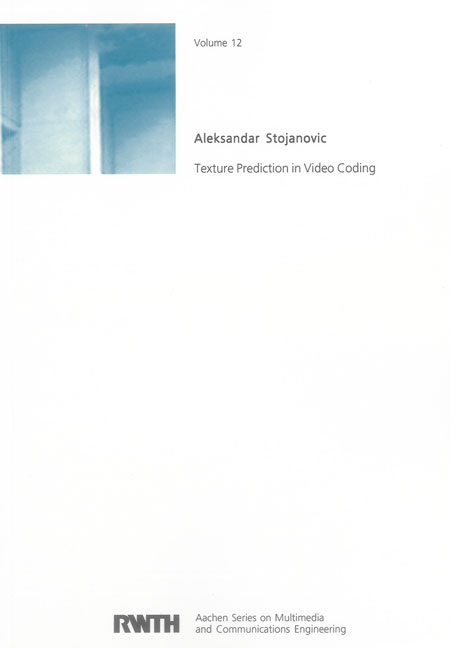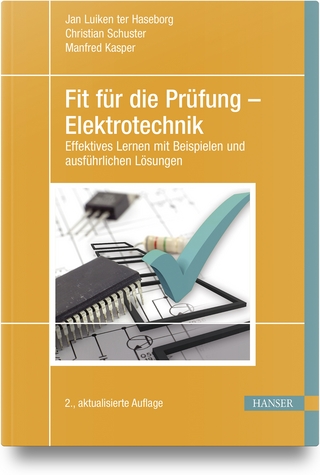
Texture Prediction in Video Coding
Seiten
2013
|
1., Aufl.
Shaker (Verlag)
978-3-8440-2276-6 (ISBN)
Shaker (Verlag)
978-3-8440-2276-6 (ISBN)
- Keine Verlagsinformationen verfügbar
- Artikel merken
This thesis deals with video compression or video source coding, that is, the problem of representing a video sequence with a given distortion using as little bitrate as possible. Even so, the expression video coding will be used as a synonym for video compression throughout this thesis. Video coding has been a very active research field in the last years and this thesis deals with techniques that further improve the compression ratio in a classical hybrid video coding system.
The concept of hybrid video coding has been predominant in the last decade since both H.264/MPEG-AVC (AVC for Advanced Video Coding) and High Efficiency Video Coding (HEVC) incorporate this concept, and in fact it has been used since H.261. The hybridity in both cases consists in the combination of motion compensation or intra prediction with transform coding. In addition, entropy coding and prediction is employed to further improve the compression ratio. This thesis is dedicated to a special type of content that is commonly referred to as texture. For the work presented in this thesis, the basic hybrid video coding was enhanced to achieve a better compression ratio for sequences containing texture. Texture can be visual texture which is then the same as texture in images, or video or dynamic texture, a slightly more complex concept which will be defined in Chapter 2. In fact, the thesis contains two major parts: the first is dealing with dynamic texture, and the second with visual texture, both in the context of video coding.
The subdivision of the thesis in two parts is rooted in the different types of video sequences employed for testing video compression algorithms, namely, sequences with static camera and sequences with camera motion. In literature, the expression pan-tilt-zoom (PTZ) is often used to refer to a moving camera, and, in this thesis, camera motion is defined in a general sense, including camera translation, rotation and zoom. The easiest way to define sequences with camera motion is by defining the opposite, sequences with static camera. Static camera means that all the change over time in the sequence is due to change in the scene, which automatically excludes zoom or camera pan. It is then logical that change in the sequence is caused by non-static objects in the scene. The coding of static regions in this type of video is particularly simple, since nothing changes over time. The principal problem lies in coding the first frame appropriately using intra coding, and after that, the content only needs to be conveyed from one frame to the other without being altered.
The concept of hybrid video coding has been predominant in the last decade since both H.264/MPEG-AVC (AVC for Advanced Video Coding) and High Efficiency Video Coding (HEVC) incorporate this concept, and in fact it has been used since H.261. The hybridity in both cases consists in the combination of motion compensation or intra prediction with transform coding. In addition, entropy coding and prediction is employed to further improve the compression ratio. This thesis is dedicated to a special type of content that is commonly referred to as texture. For the work presented in this thesis, the basic hybrid video coding was enhanced to achieve a better compression ratio for sequences containing texture. Texture can be visual texture which is then the same as texture in images, or video or dynamic texture, a slightly more complex concept which will be defined in Chapter 2. In fact, the thesis contains two major parts: the first is dealing with dynamic texture, and the second with visual texture, both in the context of video coding.
The subdivision of the thesis in two parts is rooted in the different types of video sequences employed for testing video compression algorithms, namely, sequences with static camera and sequences with camera motion. In literature, the expression pan-tilt-zoom (PTZ) is often used to refer to a moving camera, and, in this thesis, camera motion is defined in a general sense, including camera translation, rotation and zoom. The easiest way to define sequences with camera motion is by defining the opposite, sequences with static camera. Static camera means that all the change over time in the sequence is due to change in the scene, which automatically excludes zoom or camera pan. It is then logical that change in the sequence is caused by non-static objects in the scene. The coding of static regions in this type of video is particularly simple, since nothing changes over time. The principal problem lies in coding the first frame appropriately using intra coding, and after that, the content only needs to be conveyed from one frame to the other without being altered.
| Erscheint lt. Verlag | 19.10.2013 |
|---|---|
| Reihe/Serie | Aachen Series on Multimedia and Communications Engineering ; 12 |
| Sprache | englisch |
| Maße | 148 x 210 mm |
| Gewicht | 227 g |
| Einbandart | Paperback |
| Themenwelt | Technik ► Elektrotechnik / Energietechnik |
| Schlagworte | Nachrichtentechnik • Texture Prediction • video coding |
| ISBN-10 | 3-8440-2276-7 / 3844022767 |
| ISBN-13 | 978-3-8440-2276-6 / 9783844022766 |
| Zustand | Neuware |
| Haben Sie eine Frage zum Produkt? |
Mehr entdecken
aus dem Bereich
aus dem Bereich


